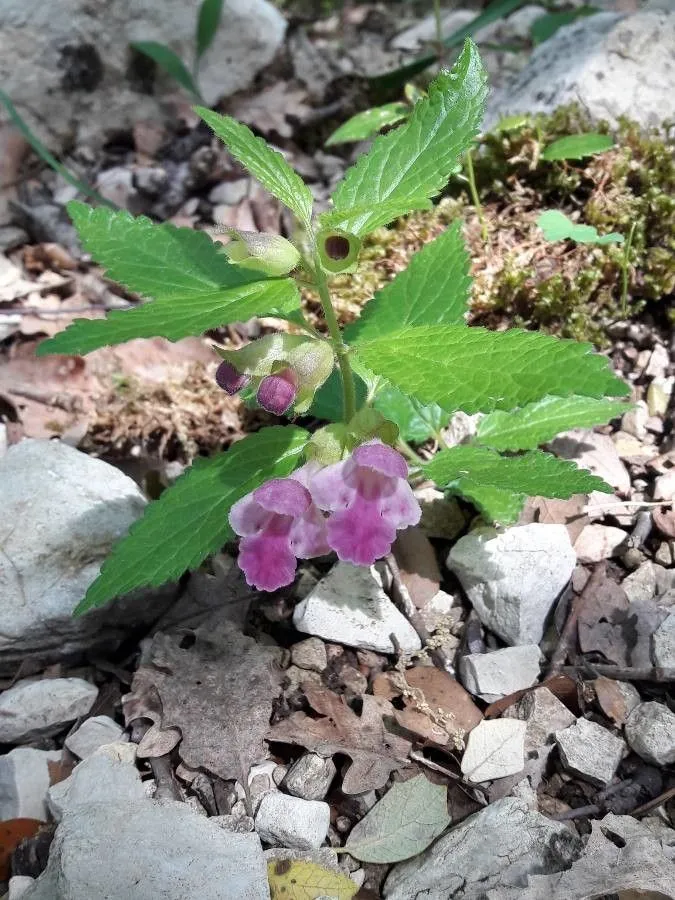
Author: L.
Bibliography: Sp. pl. 1:97. 1753
Year: 1753
Status: accepted
Rank: species
Genus: Melittis
Vegetable: False
Observations: Europe to Türkiye
Immenblatt, scientifically known as Melittis melissophyllum, is a notable member of the Lamiaceae family. This charming perennial herb is native to a broad region stretching from various parts of Europe to Türkiye, gracing diverse landscapes with its presence.
The plant is easily recognized by its lush foliage and delicate blooms. The leaves, which bear a striking resemblance to those of the lemon balm, are aromatic and serve as one of the plant’s defining features. These leaves provide a delightful backdrop for the flowers, which are predominantly white or pink, sometimes flushed with a delightful hue of purple. Each flower exhibits a beautiful corolla, making Immenblatt a visually appealing addition to any natural setting.
Immenblatt thrives in habitats that offer partial shade and well-drained soils, often gracing the undercanopies of deciduous woodlands. It prefers calcareous soils and can often be found flourishing in the dappled sunlight of these forested areas. This plant is particularly valued for its role in supporting local biodiversity. The sweetly scented flowers are highly attractive to pollinators, especially bees, hence its name “Immenblatt” which translates to “bee leaf” in English.
Historically, Immenblatt has been referenced in various botanical works, with its official scientific classification dating back to 1753, documented in Species Plantarum. The influential botanist, Carl Linnaeus, commonly abbreviated as L., is credited with its scientific nomenclature.
In the garden, Immenblatt is appreciated not only for its beauty but also for its ease of care. Gardeners seeking to add a touch of wild charm to their landscapes will find Melittis melissophyllum an excellent choice. This plant’s low maintenance requirements and delightful appeal make it a beloved selection among enthusiasts.
In summary, Immenblatt offers a wonderful combination of aesthetic beauty and ecological value. Its historical and botanical significance, coupled with its attractiveness to pollinators and easy cultivation, ensures that this graceful herb remains a cherished component of the flora from Europe to Türkiye.
Deu: immenblatt, minzenblättriges immenblatt
Eng: bastard balm
Cym: gwenynog, gwenynog lasgoch a gwyn, gwenynog wen-goch, y wenynog
En: Immenblatt, Bastard Balm, Wood Bastard Balm
Ar: تربخان نتن
Az: Çin remanniyası
Be: Кадзіла сармацкае
Bg: Маточинолистна кошутина
Ca: Melissa borda, Melissot
Hr: Medenika
Cs: Medovník meduňkolistý
Nl: Bijenblad
Fi: Mettisenmelittis
Fr: Mélitte à feuilles de mélisse
De: Immenblatt, Minzenblättriges Immenblatt, Bastardmelisse
Hu: Déli méhfű
It: Erba limonina comune, Erba limona comune, Erba-limona comune
Lt: Melisalapė medumėlė
Pl: Miodownik melisowaty
Ro: Dumbravnic
Ru: Кадило
Sk: Medúnka medovkolistá
Es: Melisa bastarda, Toronjil silvestre, Navadna medenika
Uk: Кадило сарматське
Cy: Y wenynog, Gwenynog, Gwenynog Lasgoch a Gwyn, Gwenynog Wen-Goch
: Bastard balm
© copyright of the Board of Trustees of the Royal Botanic Gardens, Kew.
© copyright of the Board of Trustees of the Royal Botanic Gardens, Kew.
© copyright of the Board of Trustees of the Royal Botanic Gardens, Kew.
Taken May 21, 2019 by Pep Secem (cc-by-sa)
Taken May 16, 2019 by Fejul Xeto (cc-by-sa)
Taken May 16, 2019 by Fejul Xeto (cc-by-sa)
Taken May 16, 2019 by Fejul Xeto (cc-by-sa)
Taken May 16, 2019 by Fejul Xeto (cc-by-sa)
Taken May 19, 2010 by Martin Bishop (cc-by-sa)
Taken Jun 3, 2020 by Alain Bigou (cc-by-sa)
Taken Jun 23, 2020 by Alain Bigou (cc-by-sa)
Taken Jun 10, 2020 by Peřina Ondřej (cc-by-sa)
Taken May 10, 2020 by Franco Colnago (cc-by-sa)
Taken May 2, 2021 by etienne copeaux (cc-by-sa)
Taken May 27, 2015 by Émile Maurice (cc-by-sa)
Taken May 17, 2022 by Léa Mariton (cc-by-sa)
Taken May 11, 2019 by Denis Bastianelli (cc-by-sa)
Taken Jun 23, 2020 by Alain Bigou (cc-by-sa)
Taken May 18, 2014 by Tela Botanica − Patrice GIRAUDEAU (cc-by-sa)
Taken May 4, 2014 by Tela Botanica − Jean-Paul HUGBART (cc-by-sa)
Taken May 26, 2015 by Tela Botanica − Liliane Roubaudi (cc-by-sa)
Taken Jun 3, 2020 by Alain Bigou (cc-by-sa)
Taken Jun 23, 2020 by Alain Bigou (cc-by-sa)
Taken May 13, 2021 by Eduard (cc-by-sa)
Taken Jun 9, 2021 by Dieter Albrecht (cc-by-sa)
Taken Dec 23, 2013 by Tela Botanica − Emmanuel STRATMAINS (cc-by-sa)
Taken May 8, 2011 by Tela Botanica − Yoan MARTIN (cc-by-sa)
Taken May 19, 2010 by Martin Bishop (cc-by-sa)
Taken Jun 29, 2013 by Tela Botanica − Liliane Roubaudi (cc-by-sa)
Taken Jun 6, 2017 by Tela Botanica − Marcel ETIENNE (cc-by-sa)
Taken Jul 21, 2022 by Alexander Baransky (cc-by-sa)
Taken Jul 21, 2022 by Alexander Baransky (cc-by-sa)
Taken May 26, 2015 by Tela Botanica − Liliane Roubaudi (cc-by-sa)
Ph maximum: 7.0
Ph minimum: 6.5
Light: 5
Atmospheric humidity: 5
Soil nutriments: 3
Family: Myrtaceae Author: (F.Muell.) K.D.Hill & L.A.S.Johnson Bibliography: Telopea 6: 402 (1995) Year: 1995 Status:…
Family: Rubiaceae Author: Pierre ex A.Froehner Bibliography: Notizbl. Bot. Gart. Berlin-Dahlem 1: 237 (1897) Year:…
Family: Sapindaceae Author: Koidz. Bibliography: J. Coll. Sci. Imp. Univ. Tokyo 32(1): 38 (1911) Year:…
Family: Asteraceae Author: A.Gray Bibliography: Pacif. Railr. Rep.: 107 (1857) Year: 1857 Status: accepted Rank:…
Family: Fabaceae Author: Medik. Bibliography: Vorles. Churpfälz. Phys.-Ökon. Ges. 2: 398 (1787) Year: 1787 Status:…
Family: Aspleniaceae Author: (Cav.) Alston Bibliography: Bull. Misc. Inform. Kew 1932: 309 (1932) Year: 1932…